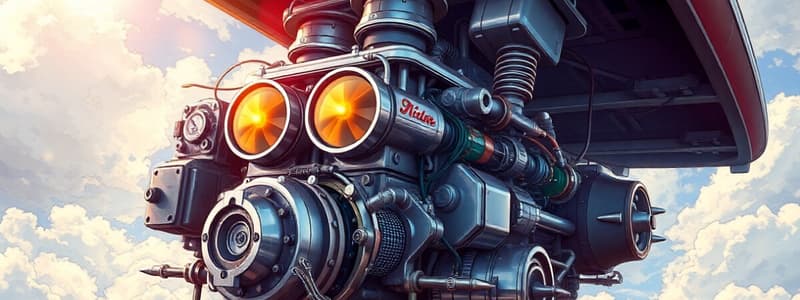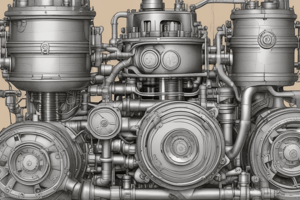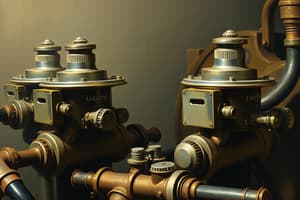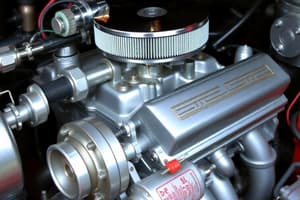Podcast
Questions and Answers
What is the primary function of a mixture control system in a carburetor?
What is the primary function of a mixture control system in a carburetor?
- To keep the engine temperature within a safe operating range.
- To maintain constant fuel pressure regardless of altitude.
- To adjust the fuel to air ratio based on atmospheric conditions. (correct)
- To increase fuel flow as atmospheric pressure decreases.
How does altitude affect air density and the carburetor's fuel mixture?
How does altitude affect air density and the carburetor's fuel mixture?
- Air density decreases, causing a richer fuel mixture as altitude increases. (correct)
- Fuel flow remains constant regardless of altitude changes.
- At higher altitudes, air is denser, resulting in leaner mixtures.
- Air density increases, leading to a richer fuel mixture.
Which of the following statements is true regarding automatic mixture control?
Which of the following statements is true regarding automatic mixture control?
- It maintains constant fuel/air ratios despite changing altitude. (correct)
- It increases fuel discharge rates at lower altitudes.
- It takes complete control away from the pilot at all times.
- It is only used in manual carburetor systems.
What happens to the weight of air passing through the induction system when an airplane climbs?
What happens to the weight of air passing through the induction system when an airplane climbs?
At 18,000 feet, how does the air density compare to sea level?
At 18,000 feet, how does the air density compare to sea level?
What is the effect of a low pressure area created by the venturi in a carburetor?
What is the effect of a low pressure area created by the venturi in a carburetor?
Which type of carburetor control is commonly used by pilots for adjusting fuel/air mixtures?
Which type of carburetor control is commonly used by pilots for adjusting fuel/air mixtures?
What typically occurs to the fuel mixture as altitude increases without adjustment?
What typically occurs to the fuel mixture as altitude increases without adjustment?
Why is a mixture control system critical for aircraft performance at high altitudes?
Why is a mixture control system critical for aircraft performance at high altitudes?
What is the primary function of the main metering system in a carburetor?
What is the primary function of the main metering system in a carburetor?
How does the idling system of a carburetor function?
How does the idling system of a carburetor function?
What is the role of the accelerating pump in the carburetor's accelerating system?
What is the role of the accelerating pump in the carburetor's accelerating system?
What causes the momentary leaning of the fuel/air mixture during rapid throttle openings?
What causes the momentary leaning of the fuel/air mixture during rapid throttle openings?
Which of the following systems is responsible for enriching fuel flow during acceleration?
Which of the following systems is responsible for enriching fuel flow during acceleration?
What function does the idle cutoff system serve?
What function does the idle cutoff system serve?
What happens to the fuel discharged from the main metering system?
What happens to the fuel discharged from the main metering system?
When does the idling system become particularly necessary in a carburetor?
When does the idling system become particularly necessary in a carburetor?
What is a consequence of having a slow response rate in the main metering system during rapid throttle opening?
What is a consequence of having a slow response rate in the main metering system during rapid throttle opening?
What critical function does the power enrichment or economizer system perform?
What critical function does the power enrichment or economizer system perform?
What is one of the main functions of the venturi in a float-type carburetor?
What is one of the main functions of the venturi in a float-type carburetor?
Which component directly controls the mass airflow through the carburetor venturi?
Which component directly controls the mass airflow through the carburetor venturi?
What does the main metering jet do in a float-type carburetor?
What does the main metering jet do in a float-type carburetor?
Which statement accurately describes the role of the float chamber in relation to the main metering system?
Which statement accurately describes the role of the float chamber in relation to the main metering system?
What is one of the potential consequences of the throttle valve being incorrectly adjusted in a carburetor?
What is one of the potential consequences of the throttle valve being incorrectly adjusted in a carburetor?
What triggers the needle valve to open in a float chamber mechanism?
What triggers the needle valve to open in a float chamber mechanism?
What happens to the needle valve when the fuel level in the float chamber is reached?
What happens to the needle valve when the fuel level in the float chamber is reached?
Which condition accurately describes how the needle valve operates when the engine is running?
Which condition accurately describes how the needle valve operates when the engine is running?
How is the discharge rate of fuel controlled in a float-type carburetor?
How is the discharge rate of fuel controlled in a float-type carburetor?
What role does atmospheric pressure play in the float chamber mechanism?
What role does atmospheric pressure play in the float chamber mechanism?
What component allows air to enter or leave the float chamber as the fuel level changes?
What component allows air to enter or leave the float chamber as the fuel level changes?
What is the primary function of the main metering system in a float-type carburetor?
What is the primary function of the main metering system in a float-type carburetor?
What occurs when the float chamber is empty of fuel?
What occurs when the float chamber is empty of fuel?
What function does the needle-type mixture control serve in a float-type carburetor?
What function does the needle-type mixture control serve in a float-type carburetor?
What occurs when the mixture control lever is placed in the 'idle cutoff' position?
What occurs when the mixture control lever is placed in the 'idle cutoff' position?
Which statement accurately describes the purpose of the power enrichment system?
Which statement accurately describes the purpose of the power enrichment system?
What potential hazard exists if the ignition is turned off while the carburetor is still supplying fuel?
What potential hazard exists if the ignition is turned off while the carburetor is still supplying fuel?
What is a primary disadvantage of float-type carburetors mentioned?
What is a primary disadvantage of float-type carburetors mentioned?
What action should be taken just before the propeller stops turning to prevent accidental kick-over?
What action should be taken just before the propeller stops turning to prevent accidental kick-over?
In pressure-type carburetors, where is fuel discharged into the airstream?
In pressure-type carburetors, where is fuel discharged into the airstream?
Which system in float-type carburetors controls the fuel/air ratio during different operating conditions?
Which system in float-type carburetors controls the fuel/air ratio during different operating conditions?
What is the main purpose of the manual mixture control in a carburetor?
What is the main purpose of the manual mixture control in a carburetor?
What happens during high power output operation regarding fuel mixture?
What happens during high power output operation regarding fuel mixture?
What distinguishes a pressure-type carburetor from a float-type carburetor in operation?
What distinguishes a pressure-type carburetor from a float-type carburetor in operation?
Which characteristic of float-type carburetors creates issues during abrupt maneuvers?
Which characteristic of float-type carburetors creates issues during abrupt maneuvers?
What is one of the significant safety concerns with unburned gases left in the system after shutting down the engine?
What is one of the significant safety concerns with unburned gases left in the system after shutting down the engine?
What role does the fuel discharge nozzle play in the carburetor?
What role does the fuel discharge nozzle play in the carburetor?
What occurs to the airflow velocity as it passes through the venturi of a carburetor?
What occurs to the airflow velocity as it passes through the venturi of a carburetor?
Which of the following describes the main metering system's function?
Which of the following describes the main metering system's function?
What effect does an air bleed have on the fuel delivery in a carburetor?
What effect does an air bleed have on the fuel delivery in a carburetor?
At which throttle setting does the economizer system begin to open?
At which throttle setting does the economizer system begin to open?
Why is a pressure differential required for fuel to flow from the discharge nozzle?
Why is a pressure differential required for fuel to flow from the discharge nozzle?
What happens to fuel at low engine speeds without an air bleed incorporated?
What happens to fuel at low engine speeds without an air bleed incorporated?
How does an air bleed contribute to fuel management in carburetors?
How does an air bleed contribute to fuel management in carburetors?
What ensures that fuel comes out of the nozzle as a fine spray?
What ensures that fuel comes out of the nozzle as a fine spray?
What is the purpose of the needle valve in the economizer system?
What is the purpose of the needle valve in the economizer system?
Why is it important to have a small air bleed hole in the fuel nozzle?
Why is it important to have a small air bleed hole in the fuel nozzle?
What detrimental effect occurs if fuel sticks to the walls of the discharge nozzle?
What detrimental effect occurs if fuel sticks to the walls of the discharge nozzle?
What requirement exists for the pressure differential at the discharge nozzle to initiate fuel flow?
What requirement exists for the pressure differential at the discharge nozzle to initiate fuel flow?
Flashcards
Carburetor Systems
Carburetor Systems
Carburetors have six systems which work together to provide engine operation at different loads and speeds.
Main metering system
Main metering system
Delivers fuel at speeds above idling, based on pressure drop in venturi.
Idling system
Idling system
Supplies fuel at low speeds where the main metering system is ineffective.
Accelerating system
Accelerating system
Signup and view all the flashcards
Accelerating pump
Accelerating pump
Signup and view all the flashcards
Idle Jet
Idle Jet
Signup and view all the flashcards
Float-Type Carburetors
Float-Type Carburetors
Signup and view all the flashcards
Differential pressure
Differential pressure
Signup and view all the flashcards
Throttle valve
Throttle valve
Signup and view all the flashcards
Lean mixture
Lean mixture
Signup and view all the flashcards
Mixture Control System
Mixture Control System
Signup and view all the flashcards
Fuel/Air Ratio
Fuel/Air Ratio
Signup and view all the flashcards
Air Density
Air Density
Signup and view all the flashcards
Altitude Effect on Mixture
Altitude Effect on Mixture
Signup and view all the flashcards
Automatic Mixture Control
Automatic Mixture Control
Signup and view all the flashcards
Manual Mixture Control
Manual Mixture Control
Signup and view all the flashcards
Venturi
Venturi
Signup and view all the flashcards
Needle Type Control
Needle Type Control
Signup and view all the flashcards
Back-suction Type Control
Back-suction Type Control
Signup and view all the flashcards
Float Chamber Mechanism
Float Chamber Mechanism
Signup and view all the flashcards
Float Chamber Mechanism (empty)
Float Chamber Mechanism (empty)
Signup and view all the flashcards
Float Chamber Mechanism (full)
Float Chamber Mechanism (full)
Signup and view all the flashcards
Float-Type Carburetor (running)
Float-Type Carburetor (running)
Signup and view all the flashcards
Fuel Flow Regulation
Fuel Flow Regulation
Signup and view all the flashcards
Constant Fuel Level
Constant Fuel Level
Signup and view all the flashcards
Venturi and Air Velocity
Venturi and Air Velocity
Signup and view all the flashcards
Venturi function
Venturi function
Signup and view all the flashcards
Discharge nozzle
Discharge nozzle
Signup and view all the flashcards
Main metering orifice (jet)
Main metering orifice (jet)
Signup and view all the flashcards
Float-Type Carburetor Mixture Control
Float-Type Carburetor Mixture Control
Signup and view all the flashcards
Rich Mixture
Rich Mixture
Signup and view all the flashcards
Idle Cutoff
Idle Cutoff
Signup and view all the flashcards
Idle Cutoff System
Idle Cutoff System
Signup and view all the flashcards
Power Enrichment System
Power Enrichment System
Signup and view all the flashcards
Economizer
Economizer
Signup and view all the flashcards
Carburetor Icing
Carburetor Icing
Signup and view all the flashcards
Float-Type Carburetor Disadvantages
Float-Type Carburetor Disadvantages
Signup and view all the flashcards
Pressure-Type Carburetor
Pressure-Type Carburetor
Signup and view all the flashcards
Pressure-Type Carburetor Advantages
Pressure-Type Carburetor Advantages
Signup and view all the flashcards
Carburetor Idle Cutoff Prevents
Carburetor Idle Cutoff Prevents
Signup and view all the flashcards
Fuel Shut-Down Engine Stop
Fuel Shut-Down Engine Stop
Signup and view all the flashcards
Power Enrichment System Function
Power Enrichment System Function
Signup and view all the flashcards
Venturi Throat
Venturi Throat
Signup and view all the flashcards
Fuel Discharge Nozzle
Fuel Discharge Nozzle
Signup and view all the flashcards
Main Metering Orifice
Main Metering Orifice
Signup and view all the flashcards
Metering Force
Metering Force
Signup and view all the flashcards
Fuel Spray
Fuel Spray
Signup and view all the flashcards
Pressure Differential
Pressure Differential
Signup and view all the flashcards
Air Bleed
Air Bleed
Signup and view all the flashcards
Economizer System
Economizer System
Signup and view all the flashcards
Economizer Needle Valve
Economizer Needle Valve
Signup and view all the flashcards
Detonation
Detonation
Signup and view all the flashcards
Surface Tension
Surface Tension
Signup and view all the flashcards
Vaporization
Vaporization
Signup and view all the flashcards
Throttle Opening
Throttle Opening
Signup and view all the flashcards
Float Chamber
Float Chamber
Signup and view all the flashcards
Atmospheric Pressure
Atmospheric Pressure
Signup and view all the flashcards
Study Notes
Reciprocating Engine - AVIA 1065 Carburetor Systems
- Reciprocating engines use carburetors to manage fuel and air mixtures for various engine speeds and loads.
- Each carburetor has six systems.
Carburetor Systems
- Main Metering: Supplies fuel at speeds above idling. Fuel flow is determined by pressure drop in the venturi throat.
- Idling: Necessary for low engine speeds. Main metering system may be erratic at low speeds. Idling system is used to supply fuel.
- Accelerating: Provides extra fuel during sudden increases in engine power. Airflow increases rapidly, leading to a slight time lag before fuel increases to support the power increase.
- Mixture Control: Determines the fuel-to-air ratio in the mixture. This can be adjusted in the cockpit.
- Idle Cutoff: Stops fuel discharge when the mixture control lever is set to “idle cutoff.” Used when stopping the engine.
- Power Enrichment/Economizer: Automatically increases the mixture richness during high power operation. Leaner mixtures are desirable for cruising and economic operation.
Float-Type Carburetors
- Accelerating System: Provides extra fuel during sudden increases in engine power. Carburetor often has a small accelerating pump to supply the extra fuel.
- Idling System: Supports smooth engine operation at low speeds. Engine may stumble or not start if this system does not work.
- Mixture Control System: Two main types of cockpit controls, needle-type and back suction type, are used to adjust fuel/air mixtures.
Carburetor Types
- Float-Type: Most common type. Disadvantages include icing tendency. Fuel must be discharged at low pressure, which can lead to incomplete vaporization and difficulties with supercharged engines.
Carburetor Systems - Additional Details
- Mixture control system: Necessary to adjust the mixture ratio as pressure and density of the air change during flight.
- Economizer System: Used for cooling and maximum power output, increasing the fuel-air ratio when needed.
- Important to understand the operation of each individual system, and how they work together. Individual systems function as a unit and may not be operated independently, especially when the engine is running.
Reciprocating Engines - Additional
- The pages provide additional information regarding stopping procedures when controlling the engine.
Additional Notes/Summary Comments
- Diagrams and illustrations were used throughout the presentation to enhance comprehension of the underlying concepts.
- The pages highlighted various aspects, including critical functions such as starting, smooth acceleration, cruise performance, and stopping procedures.
- Key technical terms, mathematical quantities/units, and procedures are emphasized.
Studying That Suits You
Use AI to generate personalized quizzes and flashcards to suit your learning preferences.




